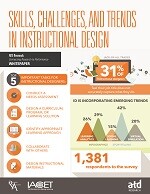Through a collaborative partnership between the Association for Talent Development (ATD), the International Association for Continuing Education and Training (IACET), and Rothwell & Associates (R&A), the R&A research team implemented a research study to investigate the proposed questions. The findings were recently released in a new ATD white paper, Skills, Challenges, and Trends in Instructional Design, which summarizes the literature review and results of the qualitative and quantitative data analysis.
The study uncovered three major findings:
- The skills required in the ID area of expertise (AOE) developed by ATD remain highly relevant in today’s evolving field.
- Although technology is constantly changing, the challenges faced by instructional designers are less about technology and more about serving the multitude of varied learners, as well as maintaining momentum and a relationship with the subject matter expert (SME).
- ID has evolved over the past couple of decades and there is an ongoing need to promote the value and understanding of the ID professional’s role in talent development (TD).
As instructional designers move forward in this evolving industry, data from the study points to several tips instructional designers can xxx to strengthen their skills.
Develop a 30-second elevator speech. Develop a good value-add 30-second “What is an instructional designer?” speech. This is not only great for networking functions (and maybe family reunions), but as a conversation starter when you meet your design team, especially your SME, for the first time at a kickoff meeting.
Design mobile first. Incorporate the design principle of “mobile first” as you begin a new project or redesign existing projects. Users want their learning programs to be more accessible and on demand. The 21st-century workforce is filled with individuals who have grown up with mobile devices, and technological advances range from ease of travel to ease of communicating through various telecommunication networks.
Be a coach. When interviewing a potential instructional designer, be sure to include coaching competency questions such as “How do you work, or imagine you would work, in a context in which you need to get course content from your subject matter experts over whom you have no formal authority?” Consider using role-play in an interview or on the job to strengthen needed soft skills. Not only ask powerful questions, but also demonstrate active listening.
Keep presence. Use face-to-face (or video conferencing) for the kickoff meeting and periodic status meetings to keep project (and relationship) momentum. Be sure you share and follow an agenda to respect time.
Be an active and reflective agent. Most evaluations are summative, and are conducted and analyzed well after courses and training have been delivered. Survey the participants at the beginning (expectations), middle (adjustments), and end of the learning delivery (revisions). Keep a list of design ideas for future possibilities and remember that the SME may become more open to these ideas over time. Asking participants the right questions at the beginning can also reveal learner characteristics, including cultural diversity and user interface design considerations.
Remember the artist. Recognize you can wear many hats: instructional designer, project manager, manufacturer, engineer, architect, artist, coach, and cheerleader. Find time to explore and experiment the artist in you through the emerging technologies of mobile learning, augmented reality, wearables, and MOOCs. Embrace failure and engage in continuous self-criticism as you innovate and change.
Think like a Millennial. Millennials are expected to take over the workforce as the highest number of workers, so incorporate the learning characteristics of Millennials through game-based learning and social learning. Storytelling is a powerful tool that can strengthen the learning experience if it is correctly incorporated into the design. It is imperative to identify realistic stories that will support effective learning for the target user group.
To learn more, download Skills, Challenges, and Trends in Instructional Design.


